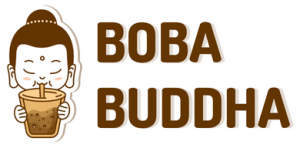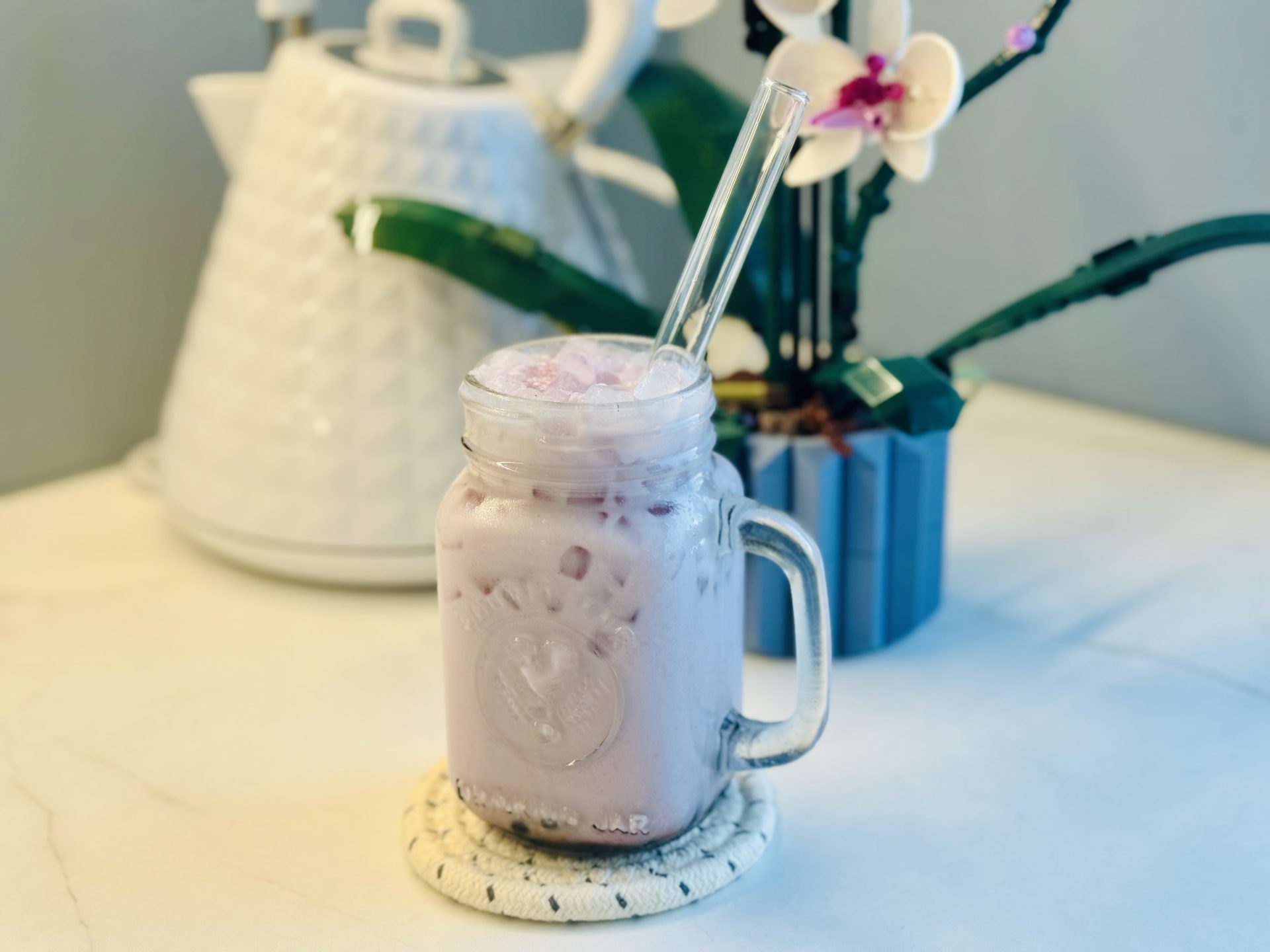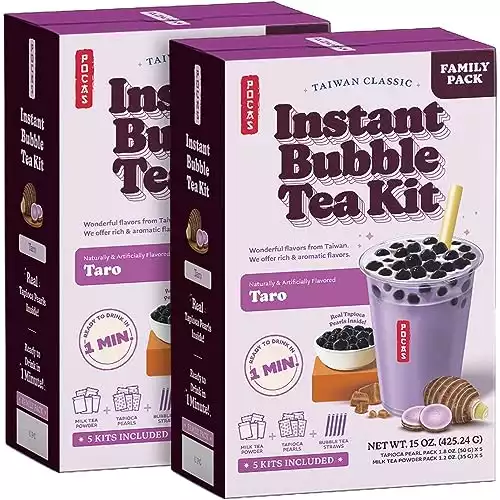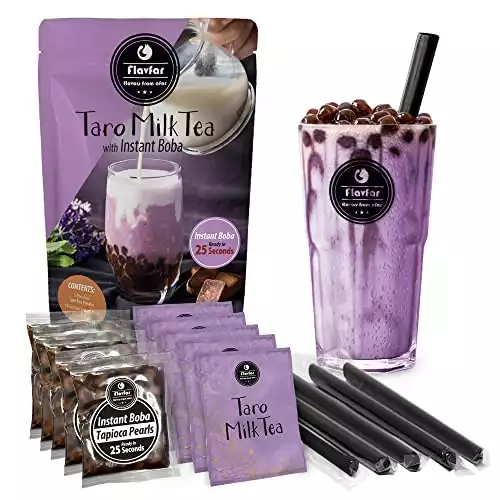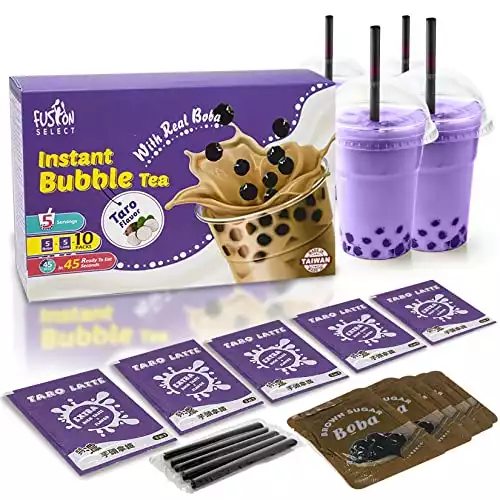Taro milk tea is a delicious and refreshing milk tea variety that was first concocted in Taiwan in the 1980s. This tea is made with jasmine tea, tapioca balls, sweeteners, and taro powder. What makes taro milk tea so popular is its distinct purple color and creamy, smooth texture.
Taro’s distinctively sweet and nutty flavor makes it a popular choice for various Asian desserts and dishes. It also pairs perfectly with milk and tea and is a beautiful purple color that makes it stand out.
Feel free to customize the sweetness level in the following recipe to suit your tastes! If you’re used to full sweetness at bubble tea shops, opt for 3 tablespoons of simple syrup. I prefer 25% sweetness and only used 1 tablespoon of simple syrup.
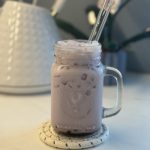
Taro Milk Tea With Tapioca Pearls
- Total Time: 40 minutes
- Yield: 1 1x
Description
Taro is one of the most-requested bubble tea flavors because of how sweet and creamy it is. This easy Taro Milk Tea recipe is fully customizable! Choose the type of milk you like best, adjust the sweetness level by adding more or less simple syrup, and go caffeine-free by omitting the tea!
Ingredients
- 1/4 cup homemade or packaged tapioca pearls
- 1/3 cup cane sugar
- 1 1/3 cup water
- 1 – 2 tbsp taro powder or fresh taro paste
- 1 cup whole milk or coconut milk
- 1 – 2 tbsp simple syrup
- 1 teabag of jasmine tea (or 1.5 tsp loose leaf tea)
- Ice
Instructions
- Cook the tapioca pearls according to the package directions. Typically, it will take 20 minutes over medium heat for fresh boba, or 2-3 minutes for quick-cooking boba.
- As you simmer the boba, whisk ⅓ cup of dark brown cane sugar and ⅓ cup of water together in a mixing bowl until the sugar dissolves.
- Strain the tapioca pearls and run them under cool water.
- Combine the boba and the sugar mixture and soak the pearls for about 30 minutes.
- Brew the jasmine tea in boiling water for 8 minutes and allow it to cool to room temperature.
- Once the boba and jasmine tea is ready, mix the taro-flavored powder, milk, and simple syrup in a blender for 30 seconds.
- Add the tapioca pearls to a glass, add the ice, and then pour the taro milk tea over the ice. Enjoy!
Notes
If you prefer non-traditional toppings, consider adding grass jelly, pudding, or nata de coco instead of boba.
Black tea or green tea may also be used instead of jasmine tea leaves.
To make simple syrup, combine equal parts water and sugar in a saucepan. Allow it to simmer until all the sugar has dissolved and the mixture reaches a syrupy consistency.
If you prefer other dairy-free milk options, you may also opt for plant-based milk such as soy or almond milk. If you are vegan, read the ingredients to ensure the powdered taro doesn’t include milk powder.
- Prep Time: 10 minutes
- Cook Time: 30 minutes
Is Taro a Vegetable?
Yes, taro is a starchy root vegetable. It is commonly used as a sweet potato substitute in Asian cuisine. Taro has a more floral and nutty flavor profile than other starchy vegetables.
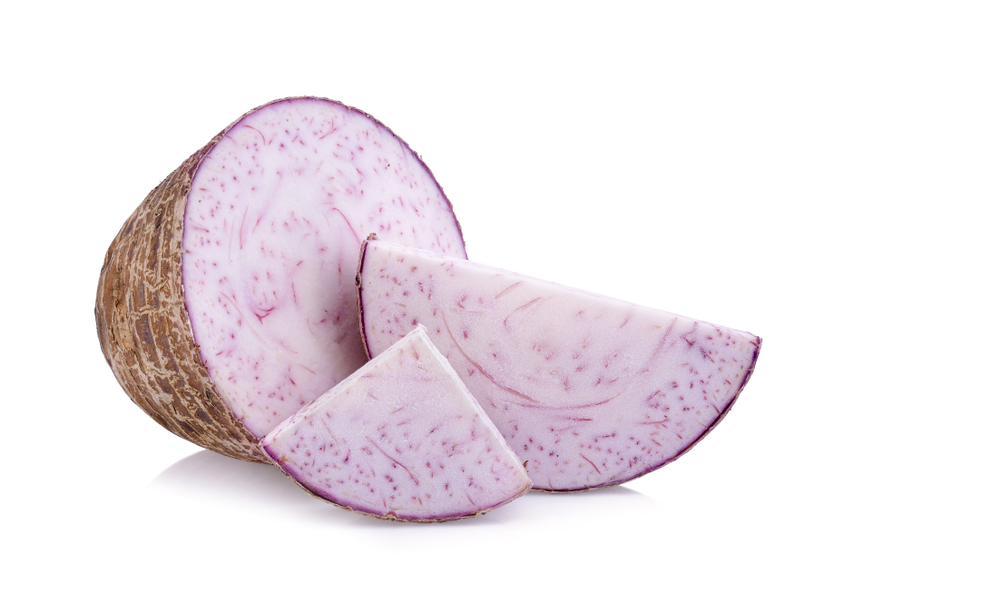
What Does Taro Milk Tea Taste Like?
When blended with milk and tea, this purple drink is a creamy and thick beverage with a slightly nutty taste. Many people say that taro milk tea tastes like fruity vanilla. It is also somewhat sweet with a smooth and refreshing finish.
If you prefer less sweet taro tea, you can request Taiwanese bubble tea shops to adjust the sweetness level or add less sugar syrup when making it at home. Unsweetened taro milk tea still carries a signature sweetness from the taro root itself, so you’re not missing out on any flavors by lowering the sugar.
What are the Best Taro Milk Tea Powders?
There are many different types of taro milk tea powder. Some have added sweeteners, and dyes to make them appear a darker purple color. Taro Milk Tea powder comes in both dairy and non-dairy versions. The Taro Milk Tea powder I use in the recipe video is a dairy version that can be found on Amazon. Another great option is to purchase a Taro Latte Kit which has everything you need like these kits below:
Is Taro Boba Healthy?
In its vegetable form, taro is a good source of fiber, potassium, calcium, vitamin C, vitamin A, and vitamin B6. It also has bioactive molecules that help assist the body in fighting against cancer and carcinogens. Compared to traditionally-brewed milk tea, taro boba milk tea is much richer in nutrients.
How Much Sweetener Should You Add to Taro Boba Tea?
Taro straight from the root is naturally sweet and flavorful. You can enjoy sipping on taro tea without any added sugar.
However, sugar syrups are great for elevating the flavors of taro tea. If you’re making taro boba tea from scratch, we recommend adding between one and two tablespoons of simple syrup. This will give the tea a light sweetness that’s not too overpowering.
Why Are Taro Bubble Teas Different Colors?
Taro roots vary in coloration; some may be pink, others purple, and a few white. Some taro powder producers also add artificial dyes to make the taro beverage look more vividly purple.
Depending on your taro powder, your taro bubble tea may turn out in different colors. It will have a gray-purple hue if you’re determined to drink taro milk tea made from fresh taro root.
